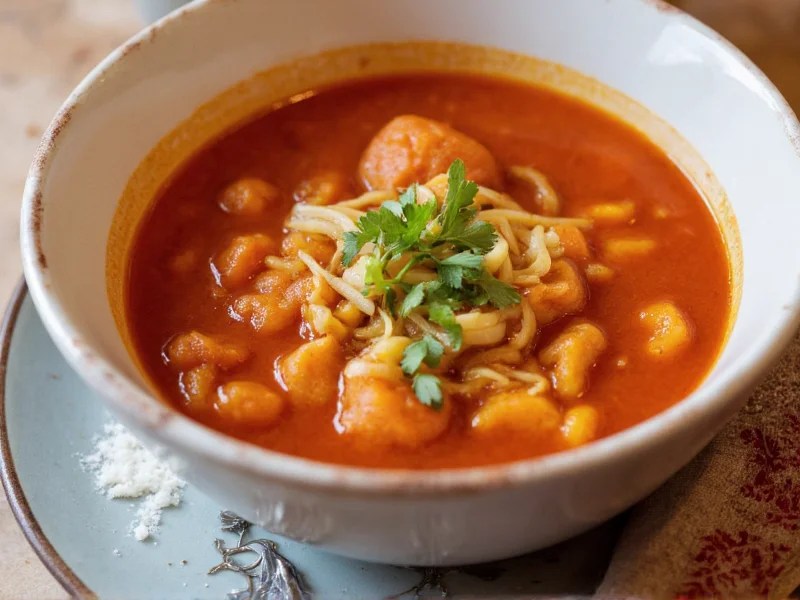When searching for “tuscano soup,” you're likely looking for information about traditional Tuscan vegetable soup from Italy's Tuscany region. The correct term is “Tuscan soup,” with “tuscano” being a common misspelling. This hearty, nutritious dish represents centuries of Italian culinary tradition, particularly the famous ribollita that embodies la cucina povera (the poor kitchen) philosophy of resourceful cooking.
Understanding Authentic Tuscan Soup
Tuscan soup isn't a single recipe but rather a category of vegetable-based soups originating from Tuscany, Italy. The most celebrated version is ribollita, which translates to “reboiled.” This name reflects its traditional preparation method where leftover minestrone was reheated multiple times, with each reheating improving the flavor.
Ribollita emerged from Tuscany's agricultural communities as a practical solution for using stale bread and seasonal vegetables. Historically, Tuscan peasants would prepare large batches of this soup at the beginning of the week, reheating it daily with additional ingredients. The repeated heating process allowed flavors to deepen while making the most of limited resources.
Essential Ingredients in Traditional Tuscan Soup
Authentic Tuscan soup relies on simple, high-quality ingredients that reflect Tuscany's agricultural bounty. Unlike many Americanized versions, traditional recipes contain no meat products, making them naturally vegetarian (and easily vegan).
| Core Ingredients | Traditional Purpose | Substitution Notes |
|---|---|---|
| Cannellini beans | Protein source and thickening agent | Borlotti beans work well as alternative |
| Seasonal vegetables | Foundation of flavor and nutrition | Typically includes kale, cabbage, carrots, celery |
| Stale bread | Thickener and sustenance | Must be unsalted Tuscan bread or similar |
| Extra virgin olive oil | Flavor enhancer and cooking medium | Essential quality component – no substitutes |
| Tomato paste | Depth of flavor | Fresh tomatoes in season |
Step-by-Step Authentic Ribollita Recipe
Creating an authentic Tuscan soup requires attention to technique as much as ingredients. Here's a traditional approach to making ribollita that honors its heritage while being accessible for modern kitchens:
- Prepare the base: Sauté onions, carrots, and celery in high-quality olive oil until softened
- Add vegetables: Incorporate chopped kale, cabbage, and other seasonal greens
- Build flavor: Stir in tomato paste and cook until it darkens slightly
- Add liquid: Pour in vegetable broth made from vegetable scraps (never water)
- Include beans: Add pre-cooked cannellini beans (never canned for authentic preparation)
- Simmer slowly: Cook for 1-2 hours to develop complex flavors
- Add bread: Layer stale Tuscan bread between soup portions in a pot
- Rest overnight: Allow flavors to meld before final reheating
- Serve: Reheat gently and finish with generous olive oil
Common Misconceptions About Tuscan Soup
Many “Tuscan soup” recipes found online deviate significantly from authentic preparations. Understanding these differences helps appreciate the genuine article:
- Meat additions: Traditional Tuscan soup contains no meat – adding pancetta or other meats creates a different dish
- Tomato dominance: While tomatoes appear in some versions, they shouldn't dominate the flavor profile
- Thickening agents: Authentic versions use bread, not flour or cream, for thickening
- Immediate serving: True ribollita requires resting time for flavors to develop
Nutritional Benefits of Authentic Tuscan Soup
Beyond its rich flavor, traditional Tuscan soup offers impressive nutritional advantages that align with Mediterranean diet principles. The combination of vegetables, legumes, and olive oil creates a balanced meal with numerous health benefits:
The fiber-rich vegetables and beans promote digestive health while providing sustained energy. Olive oil contributes heart-healthy monounsaturated fats and antioxidants. Unlike many commercial “health soups,” authentic Tuscan soup achieves its nutritional profile through whole food ingredients rather than fortification.
For those following plant-based diets, traditional Tuscan soup provides complete protein when served with bread, making it a nutritionally balanced meal. The high vegetable content delivers vitamins A, C, and K along with essential minerals like iron and calcium.
Variations Across Tuscany
While ribollita represents the most famous Tuscan soup, regional variations exist throughout Tuscany. Different towns and family traditions have created distinctive versions that reflect local agricultural practices:
- Winter version: Features more root vegetables and hearty greens like cavolo nero (Tuscan kale)
- Spring version: Incorporates fresh fava beans and young greens
- Coastal variation: May include seafood in some modern interpretations
- Farmhouse style: Often includes more bread and fewer vegetables
Understanding these regional differences helps appreciate Tuscan soup as a living culinary tradition rather than a single fixed recipe. When exploring authentic Tuscan soup recipes, look for those specifying regional origins for greater authenticity.
Serving and Enjoying Tuscan Soup Properly
The traditional method of serving Tuscan soup enhances both flavor and texture. Unlike many soups served piping hot, ribollita benefits from slightly cooler temperatures that allow the complex flavors to shine:
Authentic presentation involves ladling the soup into wide, shallow bowls with generous portions of both liquid and solids. The final drizzle of high-quality olive oil is essential – never cooked into the soup but added fresh at serving. Many Tuscans enjoy ribollita with a wedge of pecorino cheese on the side, though purists maintain the soup stands perfectly without dairy.
The texture should be substantial but not thick – more like a hearty stew than a thin broth. If properly prepared with the bread integration technique, the soup should have a naturally creamy consistency without any dairy products. This characteristic makes authentic Tuscan soup an excellent option for those following vegan diets seeking satisfying, protein-rich meals.











 浙公网安备
33010002000092号
浙公网安备
33010002000092号 浙B2-20120091-4
浙B2-20120091-4